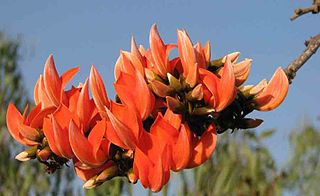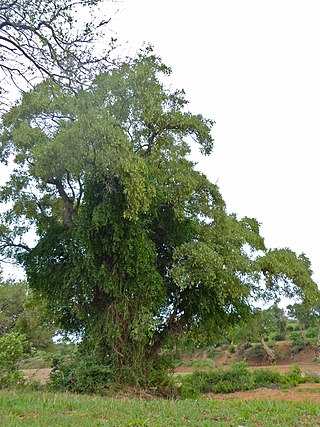
Indigofera is a large genus of over 750 species of flowering plants belonging to the pea family Fabaceae. They are widely distributed throughout the tropical and subtropical regions of the world.

Butea is a genus of flowering plants belonging to the pea family, Fabaceae. It includes five species native to the Indian Subcontinent, Indochina, Tibet, and southern China. It is sometimes considered to have only two species, B. monosperma and B. superba, or is expanded to include four or five.

Dysoxylum is a genus of rainforest trees and shrubs in the flowering plant family Meliaceae. About 34 species are recognised in the genus, distributed from India and southern China, through southeast Asia to New Guinea, Solomon Islands, and Australia. The name Dysoxylum derives from the Greek word ‘Dys’ meaning "bad" referring to "ill-smelling" and ‘Xylon’ meaning "wood".
Philenoptera kanurii, synonym Lonchocarpus kanurii, is a species of legume in the family Fabaceae. It is native to Kenya and Somalia. It is threatened by habitat loss.
Philenoptera laxiflora, synonym Lonchocarpus laxiflorus, is a species of legume in the family Fabaceae. The tree grows to 4–8 meters in height, has grey or yellowish bark and compound leaves. New leaves are accompanied by purple flowers on multi-branched panicles. The fruit is a glabrous papery pod, usually containing one seed. Ph. laxiflorus is widely distributed in West Africa, Central Africa, the African Great Lakes, and Northeast Africa. It is found in savanna woodlands and dry forested areas, particularly fringing forest near water courses.

Callerya is a genus of flowering plants in the legume family, Fabaceae. It belongs to the subfamily Faboideae, tribe Wisterieae. It includes 12 species native to the eastern Himalayas, Indochina, southern China and Taiwan, and Peninsular Malaysia. Its species are climbers, generally reaching up to about 1 m (3 ft) tall. The genus has a somewhat complicated taxonomic history; its circumscription was substantially revised in 2019.

Leptoderris is a genus of flowering plants in the family Fabaceae. It includes 22 species native to tropical Africa, ranging from Senegal to Tanzania, Malawi, Zambia, and Angola. It belongs to the subfamily Faboideae.
Rhynchotropis is a genus of flowering plants in the legume family, Fabaceae. It includes two species of herbs native to the Democratic Republic of the Congo, Angola, and Zambia. Typical habitats include seasonally-dry tropical woodland and wooded grassland in the northern Zambezian region, often in seasonally-damp or open sandy and rocky areas. It belongs to tribe Indigofereae of subfamily Faboideae.

The tribe Millettieae is one of the subdivisions of the plant family Fabaceae.

Philenoptera violacea known also as apple leaf or rain tree, Afrikaans: Appelblaar, Sotho: Mphata, Tsonga: Mohata, Zulu: Isihomohomo, IsiNdebele: Ichithamuzi, Idungamuzi, Iphanda) is a plant species in the legume family (Fabaceae).

Indigastrum is a genus of flowering plants in the tribe Indigofereae of the family Fabaceae. It includes eight species native to sub-Saharan Africa, Yemen, India, and Australia.
Microcharis is a genus of flowering plants. It includes 36 species of herbs and shrublets native to Africa and the Arabian Peninsula. The genus is in tribe Indigofereae of family Fabaceae. Typical habitats include seasonally-dry tropical forest margins, woodland, thicket, wooded grassland, and grassland, often in damp, swampy, or riverine areas, or in shallow soil over rocks.

Adinobotrys is a genus of flowering plant in the family Fabaceae, native to from Indo-China to western Malesia. The genus was first described in 1911.
Walter Carl Otto Busse was a German botanist, whose primary scholarly focus was on German agriculture and the plants, fungi and lichen of Africa.

Wisteriopsis is a genus of flowering plants belonging to the family Fabaceae. Its native range is China to Indo-China and Temperate Eastern Asia. Wisteriopsis species are twining woody vines, generally resembling species of Wisteria. The genus was established in 2019 as a result of a molecular phylogenetic study, and includes species formerly placed in Millettia or Callerya.

Austrocallerya is a genus of flowering plants belonging to the subfamily Faboideae in the family Fabaceae. They are robust, twining woody vines.

Nanhaia is a genus of flowering plants belonging to the family Fabaceae. Its native range is Southern China to Northern Vietnam.
Sigmoidala is a monotypic genus of flowering plants in the family Fabaceae, first established in 2019. Its only species is Sigmoidala kityana, native to Myanmar, northern Thailand and Laos. It was first described by William Grant Craib in 1927 as Millettia kityana.

Wisteriopsis japonica is a species of flowering plant in the family Fabaceae, native to Japan, Korea, and the Ryukyu Islands. It was first described in 1839 as Wisteria japonica.
Villosocallerya bonatiana is a species of flowering plant in the family Fabaceae, native to south-central and southeastern mainland China, Laos and Vietnam. It is the sole species in genus Villosocallerya. The species was first described in 1910 as Millettia bonatiana.












